AutoZone Bundle
How Does AutoZone Dominate the Auto Parts Market?
AutoZone, a leader in the auto parts retail sector, has built a remarkable success story. Its sustained growth highlights the importance of a robust sales and marketing strategy in the competitive automotive aftermarket. From its early focus on the DIY customer to its expansive physical presence, AutoZone has consistently adapted to maintain its market leadership.
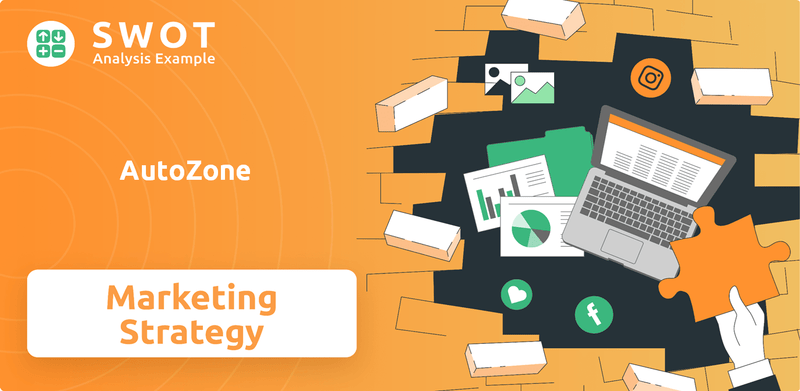
This exploration delves into AutoZone's AutoZone SWOT Analysis, revealing how its sales strategy and marketing strategy have driven its success. We'll examine its evolution from a physical retail model to a multifaceted approach, including commercial sales and a growing digital presence. Understanding AutoZone's business model provides valuable insights into its customer acquisition strategy, competitive advantage, and how it continues to increase sales through strategic initiatives in the dynamic auto parts retail landscape.
How Does AutoZone Reach Its Customers?
The sales channels of AutoZone are a crucial part of its overall Revenue Streams & Business Model of AutoZone, designed to reach a diverse customer base effectively. This multi-channel strategy integrates both online and offline platforms, ensuring accessibility and convenience for both DIY customers and professional mechanics. The company's approach focuses on a robust physical retail network complemented by a growing digital presence, driving sales and enhancing customer experience.
The cornerstone of the AutoZone sales strategy is its extensive network of physical retail locations. These stores are strategically positioned to maximize customer access and convenience. AutoZone also leverages a dedicated commercial sales program that targets professional mechanics, repair shops, and fleet operators. This multi-faceted approach helps the company capture a significant share of the auto parts retail and automotive aftermarket.
In 2024, AutoZone's sales strategy continued to evolve, with a focus on enhancing its digital capabilities and integrating them with its physical stores. This omnichannel approach aims to provide a seamless customer experience, driving sales growth and reinforcing its market position.
As of November 23, 2024, AutoZone operated a total of 7,387 stores globally. Of these, 6,455 were located in the U.S., 800 in Mexico, and 132 in Brazil. This expansive network ensures broad market coverage and accessibility for customers.
The commercial program is active in over 90% of AutoZone locations. This segment targets professional mechanics and repair shops, contributing approximately 30% of AutoZone's total revenue in 2024. The program is supported by a robust distribution network.
AutoZone has significantly developed its online presence through AutoZone.com for retail customers and AutoZonePro.com for commercial clients. E-commerce sales grew by approximately 10% in 2024. In-store pickup accounts for about 30% of online orders.
AutoZone stores offer value-added services like diagnostic testing and loan-a-tool programs. These services enhance the customer experience and drive sales. The company continues to invest in modernizing its e-commerce capabilities.
AutoZone's sales strategy relies on a combination of physical stores, a commercial sales program, and a growing online presence. These channels work together to maximize market reach and customer convenience. The company's focus on digital transformation and omnichannel integration is a key part of its AutoZone marketing strategy.
- Extensive retail network for DIY customers.
- Dedicated commercial sales program for professional clients.
- Robust e-commerce platforms for online purchases.
- Value-added services to enhance customer experience.
AutoZone SWOT Analysis
- Complete SWOT Breakdown
- Fully Customizable
- Editable in Excel & Word
- Professional Formatting
- Investor-Ready Format
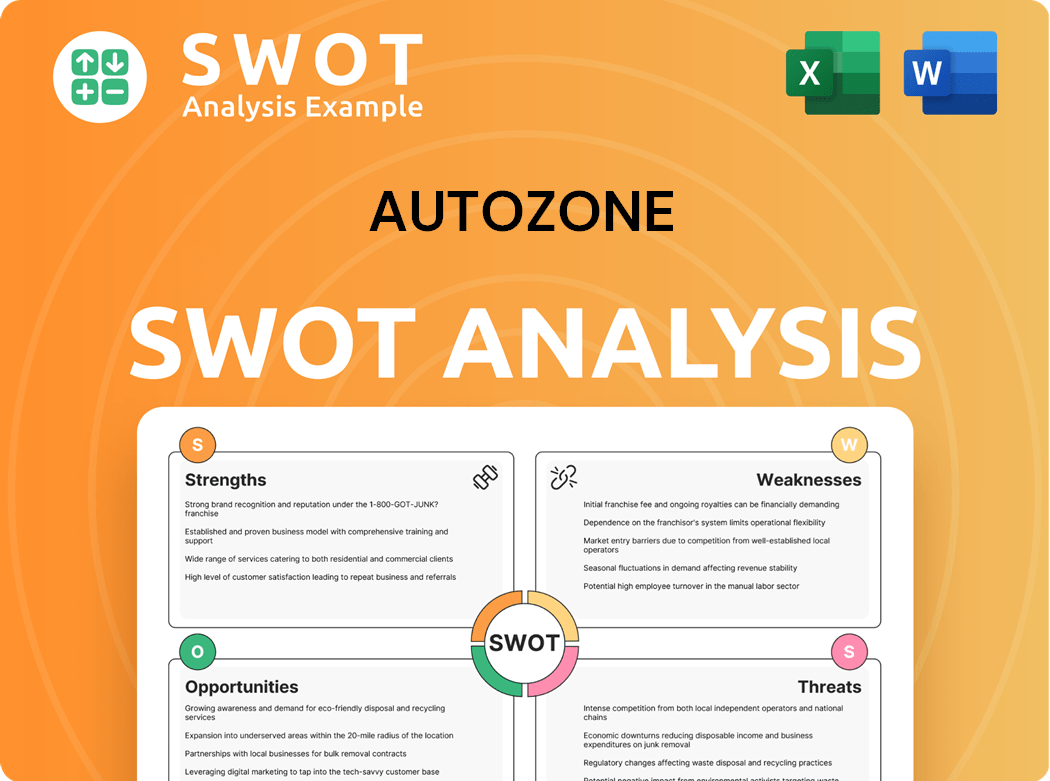
What Marketing Tactics Does AutoZone Use?
The company's marketing strategy is a blend of digital and traditional tactics designed to boost brand visibility, generate leads, and drive sales. A customer-centric approach is at the core, emphasizing excellent service and reliable advice for both DIY enthusiasts and professional clients. This focus has resulted in high customer satisfaction and a significant portion of sales from repeat customers.
Digital marketing plays a crucial role, leveraging content marketing, data-driven campaigns, and AI-powered tools to enhance customer engagement. Traditional methods, while less prominent, still contribute to reaching a broad audience. The company's strategy is dynamic, adapting to changing consumer behaviors and the increasing importance of online channels.
The company's marketing efforts are supported by a substantial budget, with approximately $400 million spent on marketing in 2024. This investment is strategically allocated across various channels to ensure maximum impact and reach its target market effectively. The company's approach is designed to maintain its competitive edge in the auto parts retail industry.
Prioritizes superior service and trustworthy advice for both DIY and professional clients, leading to high customer satisfaction. This customer-focused strategy is a key element of the company's success. The approach ensures customer loyalty and drives repeat business.
Employs content marketing through repair guides and 'how-to' videos on its website. Utilizes data-driven marketing and a retail media platform for targeted campaigns based on first-party customer data. AI-driven chatbots and virtual assistants enhance customer engagement.
AI-driven tools provide instant support, guide product selections, and troubleshoot automotive problems. Predictive analytics are used to forecast customer demand, optimize inventory, and inform pricing strategies. This technology helps in making informed decisions.
AutoZone.com and AutoZonePro.com are central to its digital marketing efforts, allowing online purchases and in-store pickup. These platforms enhance customer convenience. They also support the company's online sales strategy.
Historically included TV, radio, and print advertising to reach a broad audience. While digital marketing has grown, traditional methods still play a role. These methods help maintain brand awareness.
The 'AutoZone Rewards' loyalty program offers benefits like cashback, free battery and oil testing, and personalized maintenance reminders to its 25 million active members as of 2024. Strategic use of discounts and promotions boosts sales. The company's promotional strategies are effective.
The company's marketing strategy combines digital and traditional approaches to enhance brand awareness and drive sales. The focus on customer service and loyalty programs is crucial. The company's success is due to its effective marketing tactics.
- Content marketing through repair guides and videos.
- Data-driven marketing campaigns.
- AI-powered customer service tools.
- E-commerce platforms for online sales.
- Loyalty programs and promotional offers.
- Strategic use of discounts.
AutoZone PESTLE Analysis
- Covers All 6 PESTLE Categories
- No Research Needed – Save Hours of Work
- Built by Experts, Trusted by Consultants
- Instant Download, Ready to Use
- 100% Editable, Fully Customizable
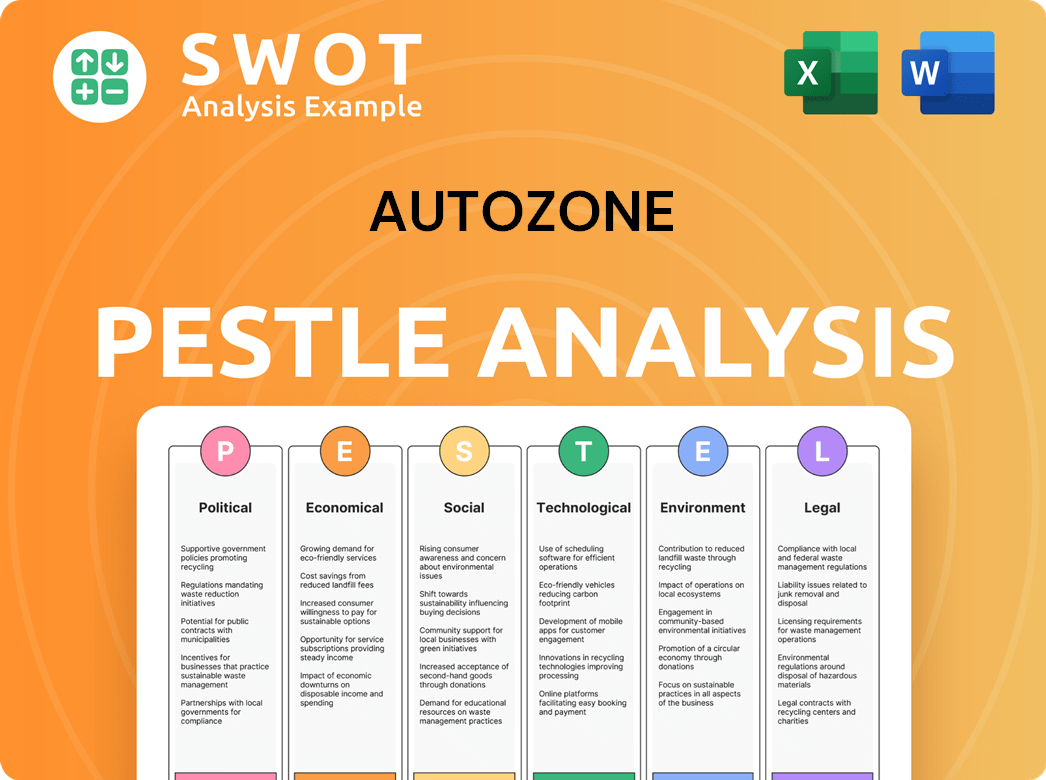
How Is AutoZone Positioned in the Market?
The brand positioning of AutoZone centers on being a dependable and convenient one-stop shop for aftermarket automotive parts and accessories. This strategy emphasizes convenience, expertise, and affordability, aiming to empower both DIY customers and professional mechanics. AutoZone's core message revolves around providing the right parts, quality products, and trustworthy advice to its customers.
A crucial element of AutoZone's brand identity is its customer-centric approach, a foundational strategy since its inception. This 'customer obsession' is designed to cultivate loyalty, with repeat customers significantly contributing to sales. The company's commitment to customer service and satisfaction is a key differentiator in the auto parts retail market.
AutoZone's visual identity, with its consistent store design and layout across its extensive network, contributes to a uniform and recognizable customer experience. This consistency reinforces the brand's image and aids in customer recognition and trust. AutoZone's focus on the DIY market, which generates approximately 80% of its revenue, further defines its brand positioning.
AutoZone appeals to its target audience by offering an extensive inventory of auto parts, including its widely recognized private-label brands. These private labels, like Duralast, Duralast Gold, and Duralast Platinum, offer quality products at competitive prices. In 2024, these private labels represented 35% of total sales, contributing to higher margins.
The company provides free services such as battery testing, engine light scanning, and loaner tools. These services empower DIY customers and build trust and loyalty. This approach supports AutoZone's customer acquisition strategy by providing added value and encouraging repeat business. This strategy helps AutoZone increase sales.
Brand consistency is maintained across physical stores and online platforms (AutoZone.com and AutoZonePro.com), ensuring a seamless customer journey. This omnichannel approach allows customers to interact with the brand in various ways, reinforcing brand recognition and convenience. This is a key element of AutoZone's digital marketing strategy.
AutoZone differentiates itself from competitors through its extensive store network (over 7,353 stores globally), its focus on the DIY market, and its robust supply chain. The company's strong brand recognition and efficient supply chain are key strengths contributing to its competitive advantage. AutoZone's market share analysis shows a strong position in the automotive aftermarket.
AutoZone's response to shifts in consumer sentiment and competitive threats involves continuous investment in digital capabilities, supply chain optimization, and international expansion. This is part of AutoZone's growth strategy. The company's commitment to adapting to market changes underscores its long-term viability and ability to maintain its competitive edge. For more insights, you can read a Brief History of AutoZone.
AutoZone Business Model Canvas
- Complete 9-Block Business Model Canvas
- Effortlessly Communicate Your Business Strategy
- Investor-Ready BMC Format
- 100% Editable and Customizable
- Clear and Structured Layout
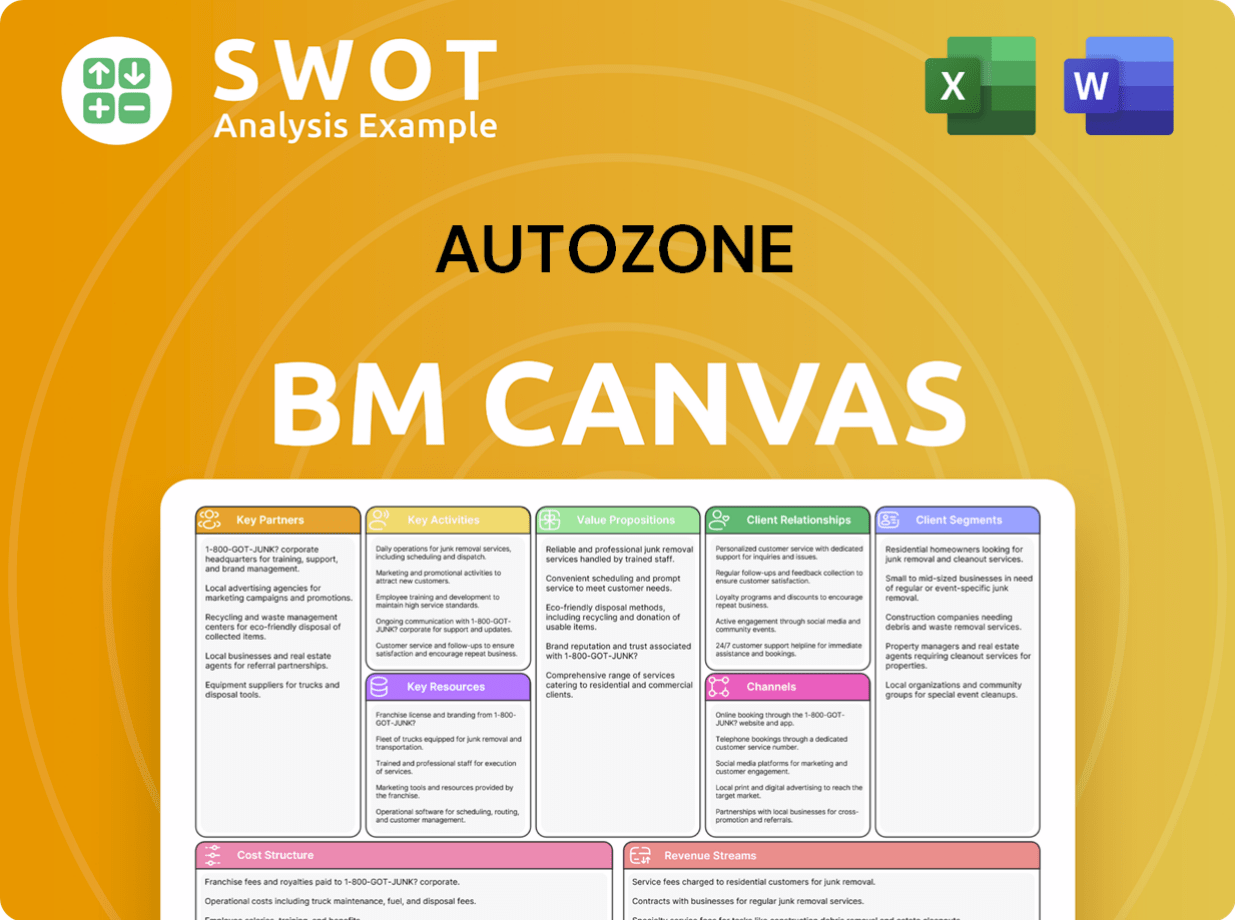
What Are AutoZone’s Most Notable Campaigns?
The sales and marketing strategies of AutoZone are centered on solidifying its position as a premier supplier of automotive parts and solutions, especially for do-it-yourself (DIY) customers, while simultaneously expanding its commercial operations. Although the company doesn't always explicitly name its campaigns in public reports, its consistent growth and operational tactics reveal key objectives and underlying creative concepts. These initiatives are crucial for driving Owners & Shareholders of AutoZone.
AutoZone's approach emphasizes customer satisfaction and providing excellent service. This commitment is evident in its in-store experiences, where knowledgeable staff offer assistance, and through services like free diagnostic testing and the loan-a-tool program. These efforts boost customer satisfaction, which stood at 85% in 2024, and encourage repeat business, which accounts for approximately 70% of the company's sales.
Another key strategic initiative is the growth and promotion of commercial programs for professional mechanics. The goal is to capture a larger share of the 'Do-It-for-Me' (DIFM) market. This campaign focuses on prompt delivery and commercial credit options, utilizing AutoZone's extensive distribution network and Mega Hubs for efficient fulfillment. Commercial sales represented around 30% of AutoZone's total revenue in 2024.
AutoZone's primary focus is on customer satisfaction, aiming to provide 'Great People, Great Service.' This approach is evident in its in-store support and services like free diagnostic testing and loan-a-tool programs. These strategies directly contribute to customer loyalty and repeat business.
A significant strategic initiative involves expanding commercial programs for professional mechanics. This aims to increase market share in the 'Do-It-for-Me' sector. Key components include rapid delivery and commercial credit options, supported by AutoZone's extensive distribution network.
The 'AutoZone Rewards' program is a continuous effort to retain customers. It offers incentives like cashback, free services, and personalized reminders to drive repeat purchases and enhance customer lifetime value. The program had 25 million active members as of 2024.
AutoZone utilizes targeted digital marketing campaigns based on first-party data through its retail media platform. In 2024, marketing spend was approximately $400 million, focusing on specific customer segments to maximize effectiveness and improve AutoZone's customer acquisition strategy.
AutoZone collaborates with organizations such as the TechForce Foundation to support students pursuing careers as automotive technicians. These partnerships enhance brand visibility and address industry needs.
- Since 2011, AutoZone has partnered with the TechForce Foundation.
- $60,000 in scholarships were donated in April 2025.
- These collaborations support the automotive community and address technician shortages.
AutoZone Porter's Five Forces Analysis
- Covers All 5 Competitive Forces in Detail
- Structured for Consultants, Students, and Founders
- 100% Editable in Microsoft Word & Excel
- Instant Digital Download – Use Immediately
- Compatible with Mac & PC – Fully Unlocked
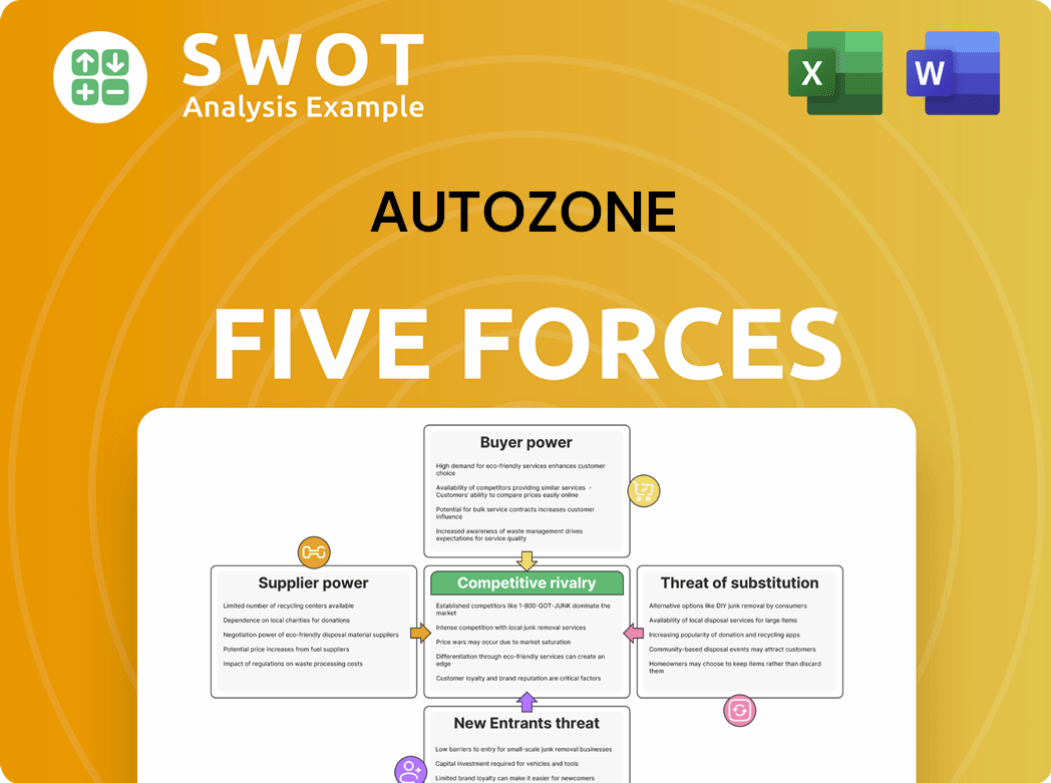
Related Blogs
- What are Mission Vision & Core Values of AutoZone Company?
- What is Competitive Landscape of AutoZone Company?
- What is Growth Strategy and Future Prospects of AutoZone Company?
- How Does AutoZone Company Work?
- What is Brief History of AutoZone Company?
- Who Owns AutoZone Company?
- What is Customer Demographics and Target Market of AutoZone Company?
Disclaimer
All information, articles, and product details provided on this website are for general informational and educational purposes only. We do not claim any ownership over, nor do we intend to infringe upon, any trademarks, copyrights, logos, brand names, or other intellectual property mentioned or depicted on this site. Such intellectual property remains the property of its respective owners, and any references here are made solely for identification or informational purposes, without implying any affiliation, endorsement, or partnership.
We make no representations or warranties, express or implied, regarding the accuracy, completeness, or suitability of any content or products presented. Nothing on this website should be construed as legal, tax, investment, financial, medical, or other professional advice. In addition, no part of this site—including articles or product references—constitutes a solicitation, recommendation, endorsement, advertisement, or offer to buy or sell any securities, franchises, or other financial instruments, particularly in jurisdictions where such activity would be unlawful.
All content is of a general nature and may not address the specific circumstances of any individual or entity. It is not a substitute for professional advice or services. Any actions you take based on the information provided here are strictly at your own risk. You accept full responsibility for any decisions or outcomes arising from your use of this website and agree to release us from any liability in connection with your use of, or reliance upon, the content or products found herein.